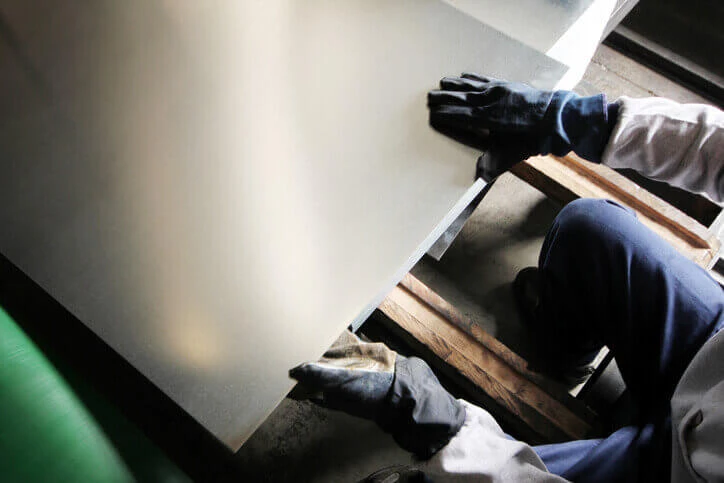Manufacturing Metal Parts: How to Make Custom Metal Parts
Making custom parts and structures through the shape, cutting, and assembly of metal components is known as metal fabrication. It transforms raw materials into finished products that are fitted to purposes using procedures including welding, bending, machining, and finishing.
Metal fabrication enables innovation and progress in a variety of fields by enabling the production of a wide range of components for businesses in the automotive, aircraft, building, electronics, and other sectors.
Types of Metal Materials For Manufacturing Metal Parts
Depending on the required qualities and application requirements, both soft and hard metals are utilized in the manufacturing of sheet metal. Because of their malleability and lightweight, soft metals like aluminum and copper are frequently utilized to create sheet metal components.
In structural and industrial applications, hard metals with high durability and strength, such as steel and stainless steel, are favored.
Below, we will discuss both soft and hard metals, each offering distinct properties and advantages for various applications.

Soft metal
Aluminum
Aluminum is frequently employed in sectors including aircraft, automotive, and construction because it is lightweight, corrosion-resistant, and extremely malleable.
Brass
Brass, a material that combines copper and zinc, is ideal for ornamental applications, plumbing, and musical instruments because of its outstanding formability, toughness, and aesthetic appeal.
Copper
Copper is used in electrical wiring, plumbing systems, and heat exchangers because of its excellent electrical conductivity and resistance to corrosion.
Hard metal
Steel
Steel is a robust and adaptable iron and carbon alloy used in the manufacturing, automotive, and construction sectors.
Stainless steel
Stainless steel is frequently used in kitchen appliances, medical equipment, and architectural constructions because it is heat-, corrosion-, and stain-resistant.
Inconel
Inconel is a nickel-based alloy used in aerospace, chemical processing, and marine applications because of its high-temperature strength and corrosion resistance.
Titanium
Due to its superior strength-to-weight ratio, titanium is preferred in the aerospace, medical, and sports equipment industries. It is also lightweight, robust, and corrosion-resistant.

Process of Custom Parts Manufacturing
Metal part manufacturing involves several procedures, including design, metal manipulation and binding, finishing, and coating, assembly, and quality control, to transform raw materials into completed components.
To assure the manufacturing of high-quality, long-lasting metal components that adhere to the specifications of different sectors, each stage calls for experience, accuracy, and attention to detail. Here are the main procedures at play:
1. Design
A thorough blueprint or CAD model of the intended metal item is created during the design process. At this stage, engineers and designers consider functionality, standards, and aesthetics.
All metal part production, including that for the automotive, aerospace, electronics, building, and consumer goods sectors, depends on design.
2. Metal Manipulation & Binding
Metal materials are shaped and joined using a variety of processes, such as:
Sheet metal bending
sheet metal bending uses sophisticated machinery, metal sheets are bent or folded to generate the necessary shapes and angles.
Manufacturing of automobile parts, enclosures, HVAC systems, and architectural structures frequently uses sheet metal bending.
Laser cutting
Complex forms and elaborate designs are made possible by the precise cutting of metal sheets by a powerful laser beam.
Industries including automotive, aerospace, electronics, and sign manufacturing employ laser cutting extensively.
Wire bending
Machines are used to manipulate metal wires to create complex structures. To create wire shapes, springs, medical devices, and unique components, wire bending is used.
Forging
A compressive force is used to heat and shape metal, increasing its strength and decreasing porosity.
Forging is frequently used to create components that need great strength in the automobile, aerospace, and heavy machinery sectors.
Extrusion
To produce lengthy, consistent profiles with cross-sectional forms, metal is pressed through a die.
Aluminum frames, tubes, and profiles are produced by extrusion for use in the building, transportation, and consumer goods sectors.
Casting and molding
The required form is created by pouring molten metal into molds and letting it set.
In the production of complicated components for the automotive, aerospace, and industrial industries, casting and molding are key procedures.
Stamping
With the use of hydraulic or mechanical presses and stamping dies, metal sheets are cut, molded, or shaped.
For the mass manufacture of components, stamping is commonly used in the automobile, appliance, and electronics sectors.
Forming
To obtain certain geometries, metal is shaped using specialized equipment like rollers, press brakes, or hammers.
Many sectors, including aerospace, shipbuilding, and general manufacturing, use forming processes.
Sheet rolling
To make uniform sheets and minimize thickness, metal sheets or plates are run through rollers.
Appliances, structural elements, and vehicle body panels are frequently produced using sheet rolling.
CNC milling and turning
According to pre-programmed instructions, CNC machines accurately cut and shape metal objects.
For producing complicated and precise components, CNC milling and turning are used in sectors including aerospace, automotive, and machinery manufacturing.
Metal 3-D printing
Using additive manufacturing processes, metal particles are fused layer by layer to produce complicated and unique pieces.
For quick prototypes and low-volume manufacturing, metal 3D printing is used in the aerospace, medical, and automotive industries.
Punching
Using punching dies and presses, metal sheets are molded or perforated. Punching is frequently used to make holes or certain forms in sectors including electronics, sheet metal production, and packaging.
Welding
Spot, MIG, and TIG welding are a few of the welding methods used to fuse metal parts. For the fabrication of structures, frames, and assemblies, welding is essential in the manufacturing, construction, and automotive sectors.
3. Finishing & Coating:
Metal components go through finishing procedures after the manufacturing process, such as grinding.
Evans Manufacturing: Reliable Parts Manufacturing On Time
Precision, quality, and creative solutions are what we at Evans Manufacturing Company provide thanks to our experience and cutting-edge skills. To discuss your project needs and discover Evans Differences, get in touch with us right now.



